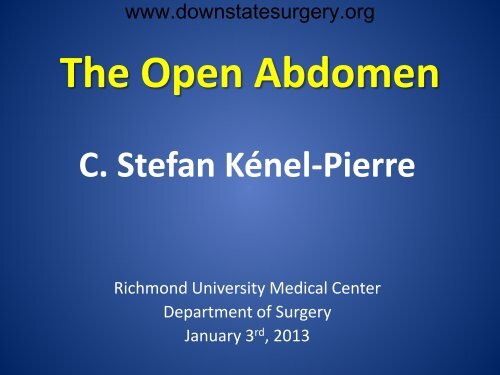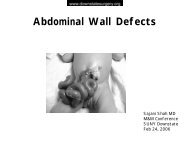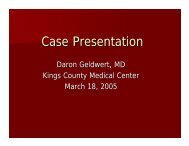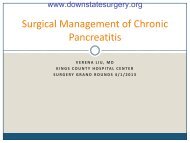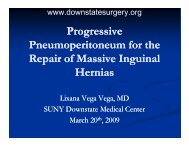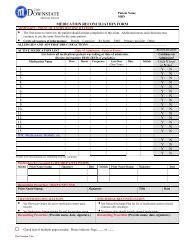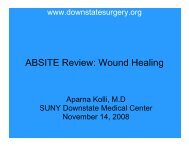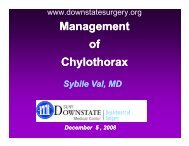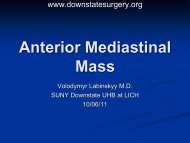The Open Abdomen - Department of Surgery at SUNY Downstate ...
The Open Abdomen - Department of Surgery at SUNY Downstate ...
The Open Abdomen - Department of Surgery at SUNY Downstate ...
You also want an ePaper? Increase the reach of your titles
YUMPU automatically turns print PDFs into web optimized ePapers that Google loves.
www.downst<strong>at</strong>esurgery.org<br />
<strong>The</strong> <strong>Open</strong> <strong>Abdomen</strong><br />
C. Stefan Kénel-Pierre<br />
Richmond University Medical Center<br />
<strong>Department</strong> <strong>of</strong> <strong>Surgery</strong><br />
January 3 rd , 2013
www.downst<strong>at</strong>esurgery.org<br />
Case Present<strong>at</strong>ion<br />
• 21M brought in by EMS s/p GSW to LUQ<br />
• No significant blood loss <strong>at</strong> scene<br />
• Complaining <strong>of</strong> pain in abdomen, speech sluggish<br />
• PMHx: asthma<br />
• PSHx: explor<strong>at</strong>ory laparotomy, SBR 2011
www.downst<strong>at</strong>esurgery.org<br />
Physical Examin<strong>at</strong>ion<br />
• Afebrile, 103/53, HR 112<br />
• Awake, arousable to voice<br />
• HEENT: PERRLA, EOMI<br />
• S1/S2 RR, equal bre<strong>at</strong>h sounds bil<strong>at</strong>erally<br />
• Abd: GSW in LUQ, active guarding, +tender<br />
• No gross blood on rectal exam<br />
• Full range <strong>of</strong> motion in all extremities
www.downst<strong>at</strong>esurgery.org<br />
Clinical Course<br />
• IV access established, intub<strong>at</strong>ed in ED<br />
• Primary survey completed, no other injuries<br />
• CXR: no traum<strong>at</strong>ic injury, ETT in place<br />
• Foley placed draining amber-colored urine<br />
• Taken to OR urgently for explor<strong>at</strong>ion
www.downst<strong>at</strong>esurgery.org<br />
Oper<strong>at</strong>ive Findings<br />
• Through & through injury to stomach<br />
• Zone I hem<strong>at</strong>oma<br />
• Hem<strong>at</strong>oma within Gerota’s fascia<br />
• Ex-lap, repair <strong>of</strong> gastrotomy & aortic lac, SBR<br />
• IV pyelogram by GU, no extravas<strong>at</strong>ion
www.downst<strong>at</strong>esurgery.org<br />
OR<br />
• Bowel markedly distended <strong>at</strong> end <strong>of</strong> case<br />
• Total oper<strong>at</strong>ive time: 4 hours<br />
• EBL: 500mL<br />
• Crystalloid: 6 liters<br />
• Replacement: 2U pRBCs, 3U FFP<br />
• Decision made to keep abdomen open<br />
• AB<strong>The</strong>ra dressing applied
www.downst<strong>at</strong>esurgery.org<br />
Postoper<strong>at</strong>ive Period<br />
• Kept intub<strong>at</strong>ed, sed<strong>at</strong>ed, no paralytics<br />
• Initial vascular exam improved with fluids<br />
• AB<strong>The</strong>ra dressing with good seal<br />
• On Cipro/Flagyl, febrile POD#0-1, 1-4<br />
• Blood/sputum/peritoneal cultures neg
www.downst<strong>at</strong>esurgery.org<br />
Hospital Course<br />
• Returned to OR POD#3 for washout & closure<br />
• No active bleeding from retroperitoneum<br />
• Fascia closed with PDS & retention sutures
www.downst<strong>at</strong>esurgery.org<br />
Hospital Course #2<br />
• POD #5/2: self-extub<strong>at</strong>ed<br />
• POD #6/3: passed fl<strong>at</strong>us, +BM; diet advanced<br />
• WBC 22.3K, contamin<strong>at</strong>ed case CT scan<br />
• Antibiotics changed to Vancomycin/Zosyn<br />
• POD 9/6: Pelvic abscess drained by IR
www.downst<strong>at</strong>esurgery.org
www.downst<strong>at</strong>esurgery.org<br />
Hospital Course #3<br />
• POD #13/10: repe<strong>at</strong> CT ↓ed collection size<br />
• Cx: E.coli sensitive to cefepime<br />
• Signed out AMA, drain removed by IR<br />
• Pt returned with pain, signed out next day<br />
• POD# 23/20: discharged home with oral ABx
www.downst<strong>at</strong>esurgery.org
www.downst<strong>at</strong>esurgery.org<br />
Questions?
www.downst<strong>at</strong>esurgery.org
www.downst<strong>at</strong>esurgery.org<br />
Background<br />
• Prior to 1980, pts tre<strong>at</strong>ed in one definitive surgery<br />
• Leaving OR early thought to increase infection r<strong>at</strong>es<br />
• Diagnoses such as ‘failure to resuscit<strong>at</strong>e’ were common<br />
• P<strong>at</strong>hophysiology <strong>of</strong> ACS not well understood<br />
• Stone 80s, Rotondo 90s: ‘Damage-control’ surgery
www.downst<strong>at</strong>esurgery.org<br />
Definition<br />
• Fascial edges intentionally unapproxim<strong>at</strong>ed<br />
• Temporizing measure allows planned escape<br />
– Correct electrolytes, medical bleeding<br />
– ICU resuscit<strong>at</strong>ion<br />
• Facilit<strong>at</strong>es repe<strong>at</strong> explor<strong>at</strong>ion, intervention
www.downst<strong>at</strong>esurgery.org<br />
Indic<strong>at</strong>ions for <strong>Open</strong> <strong>Abdomen</strong><br />
• Damage control laparotomy for trauma<br />
• Severe abdominal infection<br />
• Acute mesenteric ischemia<br />
• Necrotizing infection <strong>of</strong> the abdominal wall<br />
• Intra-abdominal hypertension
www.downst<strong>at</strong>esurgery.org<br />
Risk Factors<br />
• Preoper<strong>at</strong>ive<br />
– Blunt trauma c hemoperitoneum & hypotension<br />
– pH < 7.2; SBP < 60 mm Hg; pre-hospital intub<strong>at</strong>ion<br />
– Severe multicavitary trauma<br />
• Intraoper<strong>at</strong>ive<br />
– Transfusion > 10 pRBCs, EBL > 4L, T < 34º C<br />
– Base deficit gre<strong>at</strong>er than -6 (≥55 yrs); -15 (< 55yrs)<br />
– Absence <strong>of</strong> clot form<strong>at</strong>ion, bleeding s source
www.downst<strong>at</strong>esurgery.org<br />
Damage-Control <strong>Surgery</strong><br />
• Phase I: ex-lap, control <strong>of</strong> bleeding/spillage, packing<br />
• Phase II: ICU resuscit<strong>at</strong>ion, correction <strong>of</strong> lethal triad<br />
• Phase III: Re-explor<strong>at</strong>ion, definitive fascial closure<br />
• Phase IV: planned ventral hernia<br />
• Phase V: Abdominal wall reconstruction
www.downst<strong>at</strong>esurgery.org<br />
Abdominal Compartment Syndrome<br />
• Not an end-stage process, but a continuum<br />
• Intra-abdominal hypertension (>12 mm Hg)<br />
• IAP ≥ 20 mm Hg + organ dysfunction<br />
• Subtypes:<br />
– Primary<br />
– Secondary<br />
– Recurrent
www.downst<strong>at</strong>esurgery.org<br />
Abdominal Compartment Syndrome<br />
• Lethal effects on cardiac, pulmonary, renal fxn<br />
– Impaired oxygen<strong>at</strong>ion & increased peak pressures<br />
– Oliguria<br />
• Increased intracranial pressure<br />
• GI ischemia due to decreased splanchnic flow<br />
• Abd wall ischemia, wound complic<strong>at</strong>ions
www.downst<strong>at</strong>esurgery.org<br />
Diagnosis<br />
• Clinical suspicion is paramount<br />
• IAP measurement via bladder pressures<br />
– Instill 25-50mL <strong>of</strong> saline into empty bladder<br />
– Record pressure using arterial line transducer<br />
– Gre<strong>at</strong>er than 20 mm Hg require close monitoring<br />
– ≥25 mm Hg may benefit from decompressive lap<br />
• No definitive IAP <strong>at</strong> which ACS occurs
www.downst<strong>at</strong>esurgery.org<br />
WSACS Grades <strong>of</strong> IAH<br />
Grade<br />
IAP (mm Hg)<br />
I 12-15<br />
II 16-20<br />
III 21-25<br />
IV >25
www.downst<strong>at</strong>esurgery.org<br />
Management <strong>of</strong> IAH<br />
• Medical<br />
– Sed<strong>at</strong>ion/paralysis<br />
– Diuretics/fluid restriction<br />
– Evacu<strong>at</strong>ion <strong>of</strong> intraluminal contents (NGT, enemas)<br />
• Maintain Abdominal Perfusion Pressure
www.downst<strong>at</strong>esurgery.org<br />
Management <strong>of</strong> ACS<br />
• Medical<br />
– Sed<strong>at</strong>ion/paralysis<br />
– Diuretics/fluid restriction<br />
– Evacu<strong>at</strong>ion <strong>of</strong> intraluminal contents (NGT, enemas)<br />
• Maintain Abdominal Perfusion Pressure<br />
• Decompressive laparotomy
www.downst<strong>at</strong>esurgery.org
www.downst<strong>at</strong>esurgery.org<br />
Temporary Abdominal Closure<br />
• Easy to apply, inexpensive<br />
• Contains abdominal viscera during transport<br />
• Decreases bowel edema<br />
• Assists with evacu<strong>at</strong>ion <strong>of</strong> abdominal fluid<br />
• Prevents adhesions and abd wall retraction<br />
• Allows for expansion <strong>of</strong> abdominal contents
www.downst<strong>at</strong>esurgery.org<br />
Options for Temporary Coverage<br />
• Skin-only closure<br />
• Artificial burr (Wittman P<strong>at</strong>ch)<br />
• Absorbable mesh<br />
• Non-absorbable mesh c visceral protection<br />
• Vacuum pack<br />
• Vacuum-assisted closure (VAC) wound mgmt
www.downst<strong>at</strong>esurgery.org
www.downst<strong>at</strong>esurgery.org<br />
Bogotá Bag
www.downst<strong>at</strong>esurgery.org
www.downst<strong>at</strong>esurgery.org<br />
Mesh closure<br />
• Absorbable<br />
– Cheaper, readily available<br />
– Low primary fascial closure r<strong>at</strong>es (18-38%)<br />
– Used in cases <strong>of</strong> planned ventral hernia<br />
• Non-absorbable<br />
– Expensive<br />
– Improved fascial closure r<strong>at</strong>es (33-89%)<br />
– High enterocutaneous fistula r<strong>at</strong>e (6-18%)
www.downst<strong>at</strong>esurgery.org<br />
Wittmann Widmann P<strong>at</strong>ch
www.downst<strong>at</strong>esurgery.org<br />
Neg<strong>at</strong>ive Pressure Dressings<br />
• Barker et al., coined ‘vacuum pack’ in 1995<br />
• 3-layered technique:<br />
– Inner layer: fenestr<strong>at</strong>ed inert sheet<br />
– Middle layer: Kerlex/lap pads/blue towels + drains<br />
– Outer layer: bio-occlusive adhesive sheet (Ioban)<br />
• Known here in Brooklyn as ‘ghetto vac’
www.downst<strong>at</strong>esurgery.org<br />
AB<strong>The</strong>ra
www.downst<strong>at</strong>esurgery.org<br />
TAC Preference
www.downst<strong>at</strong>esurgery.org<br />
Study<br />
• 2,715 cit<strong>at</strong>ions were identified<br />
• 2 RCTs & 9 cohort (3 prospective) met criteria<br />
– RCT: closure with VAC + retention sutures<br />
– RCT: trend toward closure with VAC vs Barker<br />
– Prospective cohort: variable results<br />
• Low quality methodology<br />
• Risk <strong>of</strong> bias is <strong>at</strong> least moder<strong>at</strong>e
www.downst<strong>at</strong>esurgery.org
www.downst<strong>at</strong>esurgery.org<br />
Complic<strong>at</strong>ions <strong>of</strong> TAC/OA<br />
• Recurrent abdominal compartment syndrome<br />
• Hypoalbuminemia, malnutrition<br />
• Ventil<strong>at</strong>or associ<strong>at</strong>ed pneumonia<br />
• Entero<strong>at</strong>mospheric fistulae<br />
– High mortality r<strong>at</strong>es<br />
– Significant nursing/wound care burden
www.downst<strong>at</strong>esurgery.org<br />
Management <strong>of</strong> Fistulae<br />
• Prevention<br />
• Attempt to seal fistula<br />
• Control effluent<br />
• Cover with well-vascularized s<strong>of</strong>t tissue<br />
• Resect chronic fistula
www.downst<strong>at</strong>esurgery.org
www.downst<strong>at</strong>esurgery.org<br />
When to Close?<br />
• Adequ<strong>at</strong>ely resuscit<strong>at</strong>ed<br />
• Control <strong>of</strong> contamin<strong>at</strong>ion/sepsis<br />
• Warning signs <strong>of</strong> high fascial tension:<br />
– Sustained IAH (15-20 mmHg)<br />
– Rise in peak inspir<strong>at</strong>ory pressure <strong>of</strong> 10+ cm H 2 0<br />
• Failure to close: planned ventral hernia repair<br />
• Component separ<strong>at</strong>ion for non-acute setting
www.downst<strong>at</strong>esurgery.org<br />
Summary<br />
• Use open abdomen early to prevent ACS<br />
• ACS is a continuum, not a fixed st<strong>at</strong>e<br />
• TAC: neg<strong>at</strong>ive pressure & fascial approx best<br />
• Primary closure possible in 50-90% (≤ 7-10 d)<br />
• If not closed, expected VH repair in 6-12 mos<br />
• Component separ<strong>at</strong>ion in non-acute setting
www.downst<strong>at</strong>esurgery.org<br />
Questions
www.downst<strong>at</strong>esurgery.org<br />
• An 18-year-old man is admitted to the ICU after<br />
undergoing emergency laparotomy and splenectomy.<br />
He received 12 units <strong>of</strong> red blood cells and 8 units <strong>of</strong><br />
fresh frozen plasma. Over the course <strong>of</strong> the next 12<br />
hours, his abdomen becomes increasingly distended<br />
and firm, and urine output decreases significantly.<br />
Which <strong>of</strong> the following st<strong>at</strong>ements is true regarding<br />
abdominal compartment syndrome?<br />
• A Pulmonary capillary wedge pressure is typically low.<br />
B Functional residual capacity is increased.<br />
C <strong>The</strong>re is increased central venous return.<br />
D Central venous pressure is increased.<br />
E Cardiac output increases.
www.downst<strong>at</strong>esurgery.org<br />
• An 18-year-old man is admitted to the ICU after<br />
undergoing emergency laparotomy and splenectomy.<br />
He received 12 units <strong>of</strong> red blood cells and 8 units <strong>of</strong><br />
fresh frozen plasma. Over the course <strong>of</strong> the next 12<br />
hours, his abdomen becomes increasingly distended<br />
and firm, and urine output decreases significantly.<br />
Which <strong>of</strong> the following st<strong>at</strong>ements is true regarding<br />
abdominal compartment syndrome?<br />
• A Pulmonary capillary wedge pressure is typically low.<br />
B Functional residual capacity is increased.<br />
C <strong>The</strong>re is increased central venous return.<br />
D Central venous pressure is increased.<br />
E Cardiac output increases.
www.downst<strong>at</strong>esurgery.org<br />
A 35-year-old man is admitted to the surgical ICU<br />
with a diagnosis <strong>of</strong> acute alcoholic pancre<strong>at</strong>itis.<br />
Systemic inflamm<strong>at</strong>ory response syndrome<br />
(SIRS) develops and the p<strong>at</strong>ient requires 8 L <strong>of</strong><br />
fluid resuscit<strong>at</strong>ion to keep his central venous<br />
pressure higher than 10 mm Hg. You have a high<br />
index <strong>of</strong> suspicion for the development <strong>of</strong><br />
abdominal compartment syndrome (ACS). This<br />
clinical entity:<br />
A Requires immedi<strong>at</strong>e decompressive laparotomy for IAP<br />
gre<strong>at</strong>er than 20 mm Hg<br />
B Results in hypocapnia<br />
C Is associ<strong>at</strong>ed with decreased systemic vascular resistance<br />
D Will not affect cerebral perfusion<br />
E Should be suspected in any p<strong>at</strong>ient taking vasopressors<br />
who requires more than 6 L <strong>of</strong> resuscit<strong>at</strong>ive fluid over a short<br />
period
www.downst<strong>at</strong>esurgery.org<br />
A 35-year-old man is admitted to the surgical ICU with<br />
a diagnosis <strong>of</strong> acute alcoholic pancre<strong>at</strong>itis. Systemic<br />
inflamm<strong>at</strong>ory response syndrome (SIRS) develops and<br />
the p<strong>at</strong>ient requires 8 L <strong>of</strong> fluid resuscit<strong>at</strong>ion to keep<br />
his central venous pressure higher than 10 mm Hg. You<br />
have a high index <strong>of</strong> suspicion for the development <strong>of</strong><br />
abdominal compartment syndrome (ACS). This clinical<br />
entity:<br />
A Requires immedi<strong>at</strong>e decompressive laparotomy for IAP gre<strong>at</strong>er<br />
than 20 mm Hg<br />
B Results in hypocapnia<br />
C Is associ<strong>at</strong>ed with decreased systemic vascular resistance<br />
D Will not affect cerebral perfusion<br />
E Should be suspected in any p<strong>at</strong>ient taking<br />
vasopressors who requires more than 6 L <strong>of</strong><br />
resuscit<strong>at</strong>ive fluid over a short period
www.downst<strong>at</strong>esurgery.org<br />
• A 59-year-old woman with a long-standing history <strong>of</strong><br />
GERD underwent a Nissen fundoplic<strong>at</strong>ion th<strong>at</strong> was<br />
complic<strong>at</strong>ed by 2 L <strong>of</strong> blood loss and hypotension in<br />
the OR. Her vitals signs are an HR <strong>of</strong> 103 be<strong>at</strong>s/min,<br />
BP <strong>of</strong> 100/70 mm Hg, RR <strong>of</strong> 16 bre<strong>at</strong>hs/min, and Sao 2<br />
<strong>of</strong> 96%. Her urine output was 15 mL <strong>of</strong> urine per<br />
hour over the last 4 hours. Labor<strong>at</strong>ory results include<br />
a urine osmolality <strong>of</strong> 600 mOsm/kg, urine sodium <strong>of</strong><br />
15 mEq/L, plasma sodium <strong>of</strong> 140 mEq/L, urine<br />
cre<strong>at</strong>inine <strong>of</strong> 20 mg/dL, and plasma cre<strong>at</strong>inine <strong>of</strong><br />
1.5 mg/dL. Wh<strong>at</strong> is the next step in management?<br />
• A Flushing the Foley c<strong>at</strong>heter with 60 mL <strong>of</strong> normal saline<br />
B Hemodialysis<br />
C Nephrology consult<strong>at</strong>ion<br />
D Decompressive laparotomy for abdominal compartment syndrome<br />
E Administr<strong>at</strong>ion <strong>of</strong> a 1 L fluid bolus <strong>of</strong> normal saline as a fluid challenge
www.downst<strong>at</strong>esurgery.org<br />
• A 59-year-old woman with a long-standing history <strong>of</strong><br />
GERD underwent a Nissen fundoplic<strong>at</strong>ion th<strong>at</strong> was<br />
complic<strong>at</strong>ed by 2 L <strong>of</strong> blood loss and hypotension in<br />
the OR. Her vitals signs are an HR <strong>of</strong> 103 be<strong>at</strong>s/min,<br />
BP <strong>of</strong> 100/70 mm Hg, RR <strong>of</strong> 16 bre<strong>at</strong>hs/min, and Sao 2<br />
<strong>of</strong> 96%. Her urine output was 15 mL <strong>of</strong> urine per<br />
hour over the last 4 hours. Labor<strong>at</strong>ory results include<br />
a urine osmolality <strong>of</strong> 600 mOsm/kg, urine sodium <strong>of</strong><br />
15 mEq/L, plasma sodium <strong>of</strong> 140 mEq/L, urine<br />
cre<strong>at</strong>inine <strong>of</strong> 20 mg/dL, and plasma cre<strong>at</strong>inine <strong>of</strong><br />
1.5 mg/dL. Wh<strong>at</strong> is the next step in management?<br />
• A Flushing the Foley c<strong>at</strong>heter with 60 mL <strong>of</strong> normal saline<br />
B Hemodialysis<br />
C Nephrology consult<strong>at</strong>ion<br />
D Decompressive laparotomy for abdominal compartment syndrome<br />
E Administr<strong>at</strong>ion <strong>of</strong> a 1 L fluid bolus <strong>of</strong> normal saline as a<br />
fluid challenge


